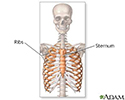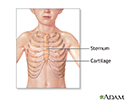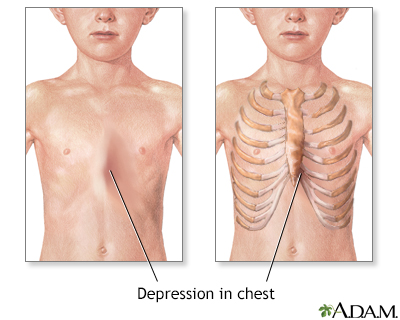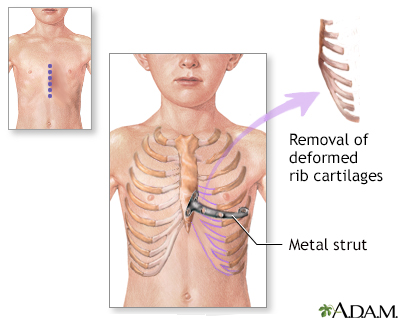Pectus excavatum
Funnel chest; Cobbler's chest; Sunken chestPectus excavatum is a medical term that describes an abnormal formation of the rib cage that gives the chest a caved-in or sunken appearance.
Considerations
Pectus excavatum occurs while a baby is developing in the womb. It can also develop in a baby after birth. The condition can be mild or severe.
Pectus excavatum is due to too much growth of the connective tissue that joins the ribs to the breastbone (sternum). This causes the sternum to grow inward. As a result, there is a depression in the chest over the sternum, which may appear quite deep.
If the condition is severe, the heart and lungs can be affected. Also, the way the chest looks may cause emotional stress for the child.
Causes
The exact cause is unknown. Pectus excavatum may occur by itself. Or there may be a family history of the condition. Other medical problems linked with this condition include:
- Marfan syndrome (connective tissue disease)
Marfan syndrome
Marfan syndrome is a disorder of connective tissue. This is the tissue that strengthens the body's structures. Disorders of connective tissue affect...
 ImageRead Article Now Book Mark Article
ImageRead Article Now Book Mark Article - Noonan syndrome (disorder that causes many parts of the body to develop abnormally)
Noonan syndrome
Noonan syndrome is a disease present from birth (congenital) that causes many parts of the body to develop abnormally. In about 50% of cases, it is ...
 ImageRead Article Now Book Mark Article
ImageRead Article Now Book Mark Article - Poland syndrome (disorder that causes muscles to not develop fully or at all)
- Rickets (softening and weakening of the bones)
Rickets
Rickets is a disorder that occurs in children before bone growth is complete. It is caused by a lack of vitamin D, calcium, or phosphate. It leads ...
 ImageRead Article Now Book Mark Article
ImageRead Article Now Book Mark Article - Scoliosis (abnormal curving of the spine)
Scoliosis
Scoliosis is an abnormal curving of the spine. Your spine is your backbone. It runs straight down your back. Everyone's spine naturally curves a b...
 ImageRead Article Now Book Mark Article
ImageRead Article Now Book Mark Article
When to Contact a Medical Professional
Contact your health care provider if you or your child has any of the following:
- Chest pain
- Trouble breathing
- Feelings of depression or anger about the condition
- Feeling tired, even when not being active
What to Expect at Your Office Visit
Your provider will perform a physical examination. An infant with pectus excavatum may have other symptoms and signs that, when taken together, define a specific condition known as a syndrome.
Physical examination
During a physical examination, a health care provider checks your body to determine if you do or do not have a physical problem. A physical examinati...

Your provider will also ask about medical history, such as:
- When was the problem first noticed?
- Is it getting better, worse, or staying the same?
- Do other family members have an unusual-shaped chest?
- What other symptoms are there?
Tests may be done to rule out suspected disorders. These tests may include:
- Chromosome studies
- Enzyme assays
Enzyme
Enzymes are complex proteins that cause a specific chemical change. For example, they can help break down the foods we eat so the body can use them....
Read Article Now Book Mark Article - Metabolic studies
- X-rays
- CT scan of the chest
CT scan
A computed tomography (CT) scan is an imaging method that uses x-rays to create pictures of cross-sections of the body. Related tests include:Abdomin...
 ImageRead Article Now Book Mark Article
ImageRead Article Now Book Mark Article
Tests may also be done to find out how severely the lungs and heart are affected.
This condition can be surgically repaired. Surgery is generally advised if there are other health problems, such as trouble breathing. Surgery may also be done to improve the appearance of the chest. Talk to your provider about treatment options.
Surgically repaired
Pectus excavatum repair is surgery to correct pectus excavatum. This is a congenital (present at birth) deformity of the front of the chest wall tha...

References
Beh HZ, Ferry AM, Dibbs RP, Buchanan EP, Monson LA. Pediatric chest and trunk deformities. In: Losee JE, Hopper RA, eds. Plastic Surgery: Volume 3: Craniofacial, Head and Neck Surgery and Pediatric Plastic Surgery. 5th ed. Philadelphia, PA: Elsevier; 2024:chap 32.
Boas SR. Skeletal diseases influencing pulmonary function. In: Kliegman RM, St. Geme JW, Blum NJ, Shah SS, Tasker RC, Wilson KM, eds. Nelson Textbook of Pediatrics. 21st ed. Philadelphia, PA: Elsevier; 2020:chap 445.
Weller JH, Nasr IW. Repair of pectus excavatum. In: Cameron JL, Cameron AM, eds. Current Surgical Therapy. 14th ed. Philadelphia, PA: Elsevier; 2023:951-992.
Pectus excavatum - illustration
Pectus excavatum is a condition in which the breast bone (sternum) appears sunken and the chest concave. It is sometimes called funnel chest. The majority of these cases are not associated with any other condition (isolated findings). However, some genetic conditions include pectus excavatum.
Pectus excavatum
illustration
Ribcage - illustration
The ribs connect on the front of the chest with the long flat sternum, or breast bone, and on the back with the vertebral column, creating a cage of protection for the lungs and heart.
Ribcage
illustration
Pectus excavatum repair - series
Presentation
Pectus excavatum - illustration
Pectus excavatum is a condition in which the breast bone (sternum) appears sunken and the chest concave. It is sometimes called funnel chest. The majority of these cases are not associated with any other condition (isolated findings). However, some genetic conditions include pectus excavatum.
Pectus excavatum
illustration
Ribcage - illustration
The ribs connect on the front of the chest with the long flat sternum, or breast bone, and on the back with the vertebral column, creating a cage of protection for the lungs and heart.
Ribcage
illustration
Pectus excavatum repair - series
Presentation
Review Date: 8/22/2023
Reviewed By: Mary C. Mancini, MD, PhD, Cardiothoracic Surgeon, Shreveport, LA. Review provided by VeriMed Healthcare Network. Also reviewed by David C. Dugdale, MD, Medical Director, Brenda Conaway, Editorial Director, and the A.D.A.M. Editorial team.








